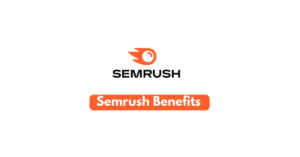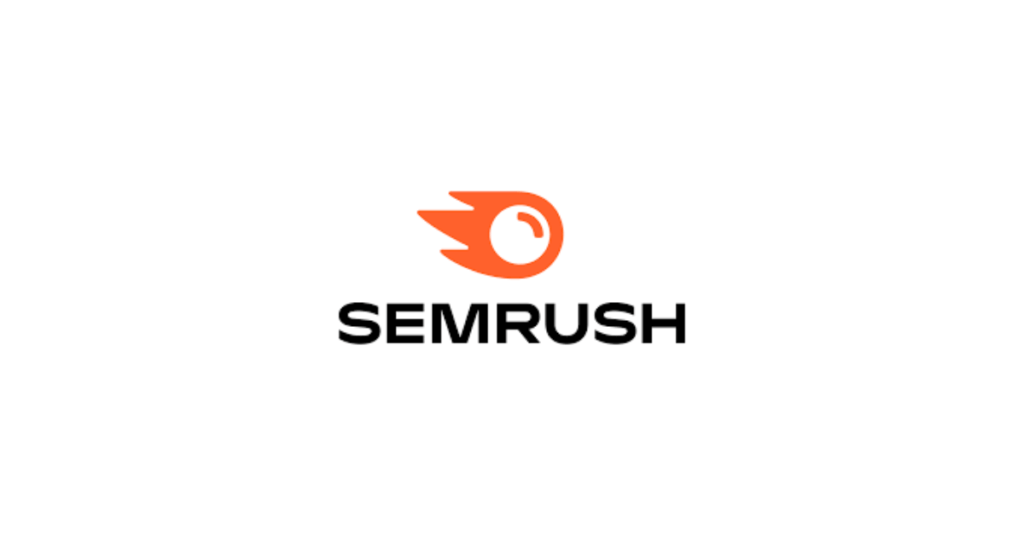Boost Your SEO, Content, & Social Media with Semrush
Gone are the days of relying solely on intuition and guesswork in your marketing efforts. Today, AI has revolutionized the landscape, offering powerful tools to optimize your strategies and achieve remarkable results. Among these innovative solutions, Semrush stands out as a comprehensive AI marketing tool designed to propel your brand to new heights.

Whether you’re a seasoned marketer or just starting, Semrush caters to your needs. Its intuitive interface and diverse features, powered by cutting-edge AI technology, empower you to tackle critical marketing challenges across various domains:
- SEO Domination: Unlock keyword insights, track competitor strategies, and optimize your website for top search engine rankings.
- Content Powerhouse: Generate engaging content ideas, analyze competitor content, and create high-performing pieces that resonate with your audience.
- Social Media Mastery: Monitor brand mentions, track competitor activity, and schedule engaging posts to reach wider audiences and drive meaningful engagement.
- Paid Advertising Prowess: Identify high-performing keywords, create compelling ad copy, and manage budgets effectively for profitable PPC campaigns.
This article is your comprehensive guide to exploring the exciting world of Semrush and its AI-powered features. Dive deeper into its functionalities, discover its benefits, and learn how it can transform your marketing efforts for lasting success. So, buckle up and prepare to unlock the hidden potential of AI-driven marketing with Semrush!
50 Ways Semrush Can Help You:
SEO:
- Track keyword rankings: Monitor your website’s position for relevant keywords and identify areas for improvement.
- Discover new keyword opportunities: Generate keyword ideas based on search volume, competition, and trends.
- Perform competitive keyword research: Analyze your competitors’ keyword strategies and identify gaps in your own.
- Optimize on-page elements: Improve title tags, meta descriptions, and headings for better search engine visibility.
- Conduct technical SEO audits: Identify and fix technical issues that could be hindering your rankings.
- Build high-quality backlinks: Find websites with high domain authority to link to your website.
- Monitor backlinks: Track your backlink profile and identify toxic backlinks to remove.
- Create content clusters: Develop content around relevant topics to improve topical authority.
- Track Google Core Web Vitals: Monitor your website’s speed, responsiveness, and visual stability for better user experience and SEO.
- Research local SEO: Optimize your website for local search results and attract customers in your area.
Content Marketing:
- Generate content ideas: Brainstorm relevant topics based on keyword research and competitor analysis.
- Analyze topic authority: Understand the competition for specific topics and identify opportunities to stand out.
- Create content briefs: Develop comprehensive briefs with keyword targets, target audience, and content length.
- Check content originality: Ensure your content is unique and avoids plagiarism.
- Analyze content performance: Track key metrics like organic traffic, social shares, and engagement.
- Identify content gaps: Find topics your competitors haven’t covered and create valuable content for your audience.
- Optimize content for search engines: Use relevant keywords and meta descriptions to improve search ranking.
- Repurpose existing content: Create different formats (e.g., infographics, videos) from existing content to reach a wider audience.
- Track content trends: Stay updated on current topics and trends to inform your content strategy.
- Analyze competitor content: See what’s working for your competitors and learn from their successes.
Social Media Marketing:
- Track social media performance: Monitor key metrics like followers, engagement, and reach.
- Identify top-performing content: Understand what resonates with your audience on each platform.
- Schedule social media posts: Plan and automate your social media content for efficient management.
- Find relevant influencers: Identify individuals with engaged audiences in your niche.
- Track competitor social media activity: Analyze their strategies and identify opportunities to differentiate yourself.
- Run social media ads: Create targeted campaigns to reach specific audiences on different platforms.
- Analyze social media sentiment: Understand how people perceive your brand and products on social media.
- Track brand mentions: Monitor online conversations about your brand and respond to feedback.
- Create engaging social media content: Use visuals, storytelling, and interactive elements to capture attention.
- Measure social media ROI: Track the return on investment from your social media efforts.
Paid Advertising:
- Keyword research for PPC: Identify high-performing keywords for your paid advertising campaigns.
- Create ad copy and landing pages: Develop compelling ad copy and landing pages to convert clicks into leads or sales.
- Manage ad budgets: Allocate your budget efficiently across different campaigns and keywords.
- Track ad performance: Monitor key metrics like impressions, clicks, conversions, and cost-per-acquisition (CPA).
- Optimize ad campaigns: Make data-driven adjustments to improve your campaign performance.
- Compare ad platforms: Analyze performance across different platforms like Google Ads, Bing Ads, and social media advertising.
- Run A/B tests: Test different ad variations to see what performs best.
- Retarget website visitors: Show targeted ads to people who have already visited your website.
- Track competitor ad spend: Monitor how much your competitors are spending on paid advertising.
- Analyze competitor ad creatives: See what kind of ads your competitors are running and learn from their strategies.
Competitive Intelligence:
- Track competitor website traffic: Monitor your competitors’ website traffic growth and sources.
- Analyze competitor backlinks: See who is linking to your competitors and identify potential backlink opportunities.
- Track competitor social media engagement: Compare your social media engagement to your competitors’.
- Analyze competitor content: See what topics your competitors are covering and how they are presenting them.
- Track competitor paid advertising:
- and identify competitor marketing channels: Understand where your competitors are investing their marketing efforts and adapt your strategy accordingly.
- Track competitor brand mentions: Monitor how people perceive your competitors’ brands online.
- Benchmark your performance: Compare your website and marketing performance to industry leaders and identify areas for improvement.
- Stay ahead of the curve: Gain insights into industry trends and competitor innovations to stay ahead of the game.
- Develop a winning marketing strategy: Use the data and insights gathered from Semrush to inform your overall marketing strategy and gain a competitive edge.
Deep Dive into SEO with Semrush:

Semrush offers a powerful suite of tools to help you optimize your website for search engines and achieve higher rankings. Let’s delve deeper into the 10 SEO functionalities you mentioned:
- Track Keyword Rankings:
- Keyword Magic Tool: Generate thousands of relevant keywords based on a seed keyword, search volume, and competition.
- Organic Positions Tracker: Monitor your website’s ranking for specific keywords over time and identify areas for improvement.
- Position Tracking History: Analyze historical ranking trends and understand what factors impacted your rankings.
- Discover New Keyword Opportunities:
- Keyword Gap Tool: Find keywords your competitors rank for but you don’t, uncovering potential opportunities.
- Keyword Difficulty Tool: Assess the difficulty of ranking for specific keywords based on competition and other factors.
- Trend Monitoring: Stay updated on emerging trends and identify keywords with increasing search volume.
- Perform Competitive Keyword Research:
- Domain Overview: Analyze your competitors’ top organic keywords and their ranking distribution.
- Backlink Gap Tool: Identify websites linking to your competitors but not you, offering potential backlink targets.
- Competitive Research Reports: Generate comprehensive reports comparing your keyword strategy to your competitors.
- Optimize On-Page Elements:
- On-Page SEO Checker: Analyze individual web pages and identify areas for improvement in title tags, meta descriptions, headings, and content structure.
- SEO Writing Assistant: Receive AI-powered suggestions for optimizing your content based on keyword relevance and search intent.
- Topic Research Tool: Explore related topics and subtopics to create comprehensive and informative content.
- Conduct Technical SEO Audits:
- Site Audit Tool: Perform a comprehensive crawl of your website and identify technical issues like broken links, slow loading times, and mobile-friendliness problems.
- Log File Analyzer: Analyze your website’s server logs to understand how search engines crawl and index your pages.
- Sitemap Generator: Create and submit XML sitemaps to help search engines discover and index your website content effectively.
- Build High-Quality Backlinks:
- Link Building Tool: Find websites with high domain authority and relevant content where you can build backlinks.
- Backlink Analytics: Analyze your website’s backlink profile, identify toxic backlinks, and track your competitor’s strategies.
- Guest Posting Tool: Find guest blogging opportunities on relevant websites to build high-quality backlinks and increase brand awareness.
- Monitor Backlinks:
- Backlink Alerts: Receive notifications whenever your website gains or loses backlinks, allowing you to track your backlink profile in real time.
- Backlink Quality Score: Assess the quality of your backlinks based on various factors like domain authority and spam score.
- Backlink Disavow Tool: Disavow low-quality or toxic backlinks to prevent them from negatively impacting your website’s rankings.
- Create Content Clusters:
- Topic Research Tool: Explore related topics and subtopics to identify relevant themes for your content clusters.
- Content Template: Utilize pre-built templates to create comprehensive content clusters covering various aspects of a specific topic.
- Performance Tracking: Track the performance of your content clusters in terms of organic traffic, engagement, and conversions.
- Track Google Core Web Vitals:
- Core Web Vitals Checker: Analyze your website’s loading speed, responsiveness, and visual stability, which are crucial factors in Google rankings and user experience.
- Technical SEO Checker: Identify technical issues that might be hindering your Core Web V Vitals performance.
- Performance Reports: Monitor your website’s Core Web Vitals score over time and track the impact of optimization efforts.
- Research Local SEO:
- Local SEO Tool: Manage your Google My Business listing and track your local search ranking for relevant keywords.
- On-Page SEO Checker: Optimize your website content and local pages for local search visibility.
- Competitor Analysis: Analyze your local competitors’ SEO strategies and identify areas for improvement.
Deep Dive into Content Marketing with Semrush:

Semrush goes beyond SEO to empower you with tools for creating high-performing content that resonates with your audience. Let’s dive into the 10 content marketing functionalities you mentioned:
- Generate Content Ideas:
- Topic Research Tool: Explore related topics, subtopics, and questions people are asking around your chosen keyword, sparking creative ideas.
- Content Market Explorer: Analyze top-performing content on specific topics, uncovering successful formats, angles, and headlines.
- Competitive Research Reports: See what types of content your competitors are creating and identify potential gaps in your own coverage.
- Analyze Topic Authority:
- Topic Authority Score: Evaluate the difficulty of ranking for a topic based on the competitiveness of existing content.
- Backlink Analytics: Assess the backlink profile of top-ranking content to understand authority-building strategies.
- On-Page SEO Checker: Analyze title tags, meta descriptions, and content structure of top-ranking pages to identify optimization opportunities.
- Create Content Briefs:
- SEO Content Template: Generate pre-filled briefs with keyword targets, search intent, and competitor analysis to guide your content creation.
- Topic Clusters: Organize your content around a central theme with suggested subtopics and supporting content formats.
- Content Calendar: Plan and schedule your content creation process for efficient management.
- Check Content Originality:
- SEO Writing Assistant: Analyze your content for plagiarism and offer suggestions for improving originality and readability.
- Content Audit Tool: Analyze your existing content for duplicate content or low-quality pages and identify areas for improvement.
- Backlink Monitoring: Track backlinks to your content and identify potential copyright infringement issues.
- Analyze Content Performance:
- Organic Traffic Insights: Track website traffic generated by specific content pieces and identify high-performing articles.
- Social Media Analytics: Monitor social shares, engagement, and brand mentions across platforms for each piece of content.
- Content Performance Reports: Generate comprehensive reports with key metrics like organic traffic, engagement, and conversions to assess content effectiveness.
- Identify Content Gaps:
- Keyword Gap Tool: Find keywords your competitors rank for but you don’t, indicating potential content opportunities.
- Topic Research Tool: Explore subtopics and questions not covered by existing content on your chosen theme.
- Content Market Explorer: Analyze trending topics with low competition, offering opportunities to be an early adopter and gain visibility.
- Optimize Content for Search Engines:
- SEO Writing Assistant: Receive real-time suggestions for optimizing your content with relevant keywords and meta descriptions.
- On-Page SEO Checker: Analyze your content structure, headings, and internal linking for search engine optimization.
- Keyword Magic Tool: Explore related keywords with search volume and competition data to optimize your content further.
- Repurpose Existing Content:
- Content Marketplace: Convert your existing content into different formats like infographics, videos, or slide decks for wider reach.
- Social Media Post Generator: Create engaging social media posts based on existing content for efficient promotion.
- Topic Clusters: Leverage existing content to build upon and create complementary pieces for a comprehensive topic coverage.
- Track Content Trends:
- Trend Monitoring Tool: Identify emerging trends and keywords related to your niche, informing your content strategy.
- Social Media Analytics: Track trending topics and discussions on social media platforms to align your content with current interests.
- Content Market Explorer: Analyze popular content formats and themes across different topics to stay ahead of the curve.
- Analyze Competitor Content:
- Content Market Explorer: See what types of content your competitors are creating, their performance metrics, and audience engagement.
- Competitive Research Reports: Compare your content strategy to your competitors in terms of topics, formats, and audience targeting.
- Social Media Analytics: Benchmark your social media performance against your competitors and identify areas for improvement.
Deep Dive into Social Media Marketing with Semrush:

Semrush provides a powerful suite of tools to manage your social media presence effectively and measure its impact. Let’s explore the 10 functionalities you mentioned in detail:
- Track Social Media Performance:
- Social Media Analytics: Monitor key metrics like follower growth, engagement (likes, comments, shares), reach, and impressions across major platforms like Facebook, Instagram, Twitter, YouTube, and LinkedIn.
- Custom Reports: Create personalized reports to track specific metrics relevant to your goals, such as brand mentions or influencer engagement.
- Competitive Analysis: Compare your social media performance to your competitors and identify areas for improvement.
- Identify Top-performing Content:
- Post Performance Analysis: Analyze individual posts across platforms to see which ones resonate best with your audience based on engagement metrics.
- Content Heatmap: Visualize the performance of your content across different platforms and identify top-performing formats and topics.
- Trending Topics Tool: Discover trending topics and hashtags relevant to your niche to inform your content strategy.
- Schedule Social Media Posts:
- Social Media Poster: Schedule posts in advance across multiple platforms for efficient content management.
- Bulk Scheduling: Upload and schedule multiple posts at once to save time and effort.
- Calendar View: Get a centralized overview of your scheduled posts across platforms for easy planning and organization.
- Find Relevant Influencers:
- Influencer Search Tool: Discover influencers in your niche based on keywords, topics, and audience demographics.
- Engagement Rate Analysis: Evaluate the engagement levels of potential influencers to ensure they resonate with your target audience.
- Social Media Analytics: Analyze influencer profiles to understand their content, audience, and performance on different platforms.
- Track Competitor Social Media Activity:
- Competitor Analysis: Track your competitors’ social media activity, including posting frequency, content themes, and engagement levels.
- Benchmarking Reports: Compare your social media performance to your competitors and identify areas where you can excel.
- Social Media Ads Insights: Analyze your competitors’ ad campaigns to understand their targeting strategies and creative approaches.
- Run Social Media Ads:
- Social Media Advertising Platform: Create and manage targeted ad campaigns across major platforms like Facebook, Instagram, and Twitter.
- Audience Builder: Define your target audience based on demographics, interests, and behaviors for effective ad targeting.
- Budget Allocation & Optimization: Allocate your ad budget efficiently and optimize campaigns for maximum return on investment.
- Analyze Social Media Sentiment:
- Brand Monitoring Tool: Track brand mentions and analyze sentiment (positive, negative, neutral) across social media platforms.
- Crisis Management Tools: Identify and respond to negative brand mentions promptly to mitigate potential damage.
- Social Media Analytics: Analyze overall sentiment towards your brand and track how it evolves over time.
- Track Brand Mentions:
- Brand Monitoring Tool: Set up alerts to be notified whenever your brand is mentioned online, including social media, news websites, and forums.
- Sentiment Analysis: Analyze the sentiment of brand mentions to understand how people perceive your brand.
- Influencer Marketing: Identify potential brand advocates and influencers through brand mentions.
- Create Engaging Social Media Content:
- Social Media Content Calendar: Plan and schedule your content calendar across platforms with different formats and themes.
- Content Ideas Tool: Generate content ideas based on trending topics, popular hashtags, and your audience’s interests.
- Visual Content Creation Tools: Utilize tools like image editing and video creation to enhance your content’s visual appeal.
- Measure Social Media ROI:
- Social Media Analytics: Track key metrics like website traffic generated from social media, leads acquired, and conversions to measure the return on investment of your social media efforts.
- Custom Reports: Create reports to track specific business goals achieved through social media, such as brand awareness increase or sales generated.
- A/B Testing: Test different social media strategies and content formats to optimize your campaigns for better results.
Deep Dive into Paid Advertising with Semrush:

Semrush offers powerful tools to fuel your paid advertising campaigns and maximize your ROI. Let’s delve into the 10 functionalities you mentioned:
- Keyword Research for PPC:
- Keyword Magic Tool: Find high-volume, low-competition keywords based on your niche, intent, and competitor analysis.
- Keyword Difficulty Tool: Assess the competitive landscape and estimate the cost per click (CPC) for targeted keywords.
- Organic Research: Uncover keywords your website already ranks for organically to inform your PPC strategy.
- Create Ad Copy and Landing Pages:
- SEO Writing Assistant: Ensure your ad copy is relevant, clear, and keyword-rich for maximum impact.
- Landing Page Audit: Analyze your landing pages for performance and identify areas for improvement in conversion optimization.
- Topic Research Tool: Explore related topics and subtopics to create comprehensive landing pages aligned with user intent.
- Manage Ad Budgets:
- Bid Management Tool: Automate bidding strategies based on your budget and desired ROAS (return on ad spend).
- Campaign Budget Optimizer: Allocate your budget across campaigns and ad groups for optimal efficiency.
- Performance Reports: Track campaign spending and identify areas where you can optimize budget allocation.
- Track Ad Performance:
- Advertising Research: Monitor key metrics like impressions, clicks, conversions, and cost-per-acquisition (CPA) across platforms.
- Competitive Research: Benchmark your performance against competitors and uncover their winning strategies.
- Custom Reports: Build personalized reports to track specific KPIs relevant to your campaign goals.
- Optimize Ad Campaigns:
- A/B Testing: Test different ad copy, targeting options, and landing pages to identify the best performing variations.
- Negative Keyword Tool: Exclude irrelevant searches from triggering your ads, saving budget and improving targeting.
- Keyword Phrase Match Options: Fine-tune your targeting with broad, phrase, and exact match options for optimal control.
- Compare Ad Platforms:
- Market Intelligence Tools: Analyze overall advertising trends and performance across different platforms.
- Competitive Research: Compare your competitors’ activity across platforms to identify potential opportunities.
- Platform-Specific Tools: Utilize dedicated tools for Google Ads, Bing Ads, and social media advertising platforms.
- Run A/B Tests:
- A/B Testing Tool: Set up and manage A/B tests for ad copy, headlines, visuals, and landing pages to optimize performance.
- Statistical Significance Analysis: Ensure your test results are statistically significant and reliable for informed decision-making.
- Reporting & Recommendations: Get insights and recommendations based on your A/B test results for data-driven optimization.
- Retarget Website Visitors:
- Audience Builder: Create custom audiences based on website visitors, demographics, and interests for targeted retargeting campaigns.
- Dynamic Remarketing: Show personalized ads to website visitors based on their browsing behavior and product interests.
- Cross-device Targeting: Reach users across different devices they use to browse and ensure consistent messaging.
- Track Competitor Ad Spend:
- Competitive Research Reports: Estimate your competitors’ ad spend based on their campaign activity and keyword targeting.
- Market Intelligence Tools: Analyze overall advertising spend trends within your industry and identify benchmarks.
- Keyword Gap Tool: Uncover keywords your competitors are bidding on but you’re not, offering insights into their strategies.
- Analyze Competitor Ad Creatives:
- Advertising Research: View competitor ad copy, headlines, and visuals across different platforms and analyze their approaches.
- Landing Page Audit: Analyze competitor landing pages to understand their messaging, design, and conversion optimization strategies.
- Competitive Insights Reports: Gain comprehensive reports comparing your ad creatives to your competitors’ for actionable learnings.
Deep Dive into Competitive Intelligence with Semrush:

Building a successful marketing strategy requires understanding your competitors. Semrush empowers you to gain valuable insights into their activities and outperform them across various channels. Let’s explore in detail the functionalities you mentioned:
Track Competitor Website Traffic:
- Traffic Analytics: Monitor your competitors’ website traffic over time, including visits, sources (organic, paid, direct, etc.), and top landing pages.
- Competitive Research Reports: Compare your website traffic to your competitors’ and identify areas where you can improve your reach and engagement.
- Market Explorer: Analyze overall traffic trends within your industry and benchmark your performance against the leaders.
Analyze Competitor Backlinks:
- Backlink Analytics: Analyze your competitors’ backlink profile to understand their link-building strategies.
- Backlink Gap Tool: Identify websites linking to your competitors but not you, uncovering potential backlink opportunities.
- Domain Comparison: Compare your backlink profile to your competitors’ and see where you stand in terms of quantity and quality of backlinks.
Track Competitor Social Media Engagement:
- Social Media Analytics: Monitor your competitors’ social media activity, including follower growth, engagement (likes, comments, shares), and top-performing content.
- Competitive Research Reports: Compare your social media performance to your competitors’ and identify areas for improvement in content strategy and engagement tactics.
- Brand Monitoring Tool: Track brand mentions across social media platforms and see how people perceive your competitors and their brand.
Analyze Competitor Content:
- Organic Research: Analyze your competitors’ top-ranking content to understand their keyword targeting, on-page optimization, and content formats.
- Content Market Explorer: Explore popular content topics within your niche and see how your competitors are covering them.
- Topic Research Tool: Discover subtopics and questions related to your target keywords and see how your competitors are addressing them.
Track Competitor Paid Advertising:
- Advertising Research: View your competitors’ paid ads across platforms like Google Ads, Bing Ads, and social media advertising.
- Estimated Traffic & Budget: Analyze estimated traffic and budget of your competitors’ paid advertising campaigns.
- Competitive Research Reports: Benchmark your paid advertising performance against your competitors’ and identify potential gaps in your strategy.
Identify Competitor Marketing Channels:
- Market Explorer: Analyze your competitors’ presence across different marketing channels, including organic search, paid advertising, social media, and display advertising.
- SEO & PPC Competitor Research Tools: Understand your competitors’ keyword strategies, search engine rankings, and paid advertising campaigns across channels.
- Social Media Competitive Analysis: See how your competitors are using different social media platforms and compare their engagement levels.
Track Competitor Brand Mentions:
- Brand Monitoring Tool: Set up alerts for your brand and your competitors’ brands to track online mentions and sentiment.
- Competitive Research Reports: Analyze overall brand sentiment towards your competitors and identify areas where you can improve your brand perception.
- Social Media Analytics: Track brand mentions across social media platforms and see how people are talking about your competitors.
Benchmark Your Performance:
- Market Explorer: Compare your website traffic, engagement, and other key metrics to industry leaders and averages.
- Competitive Research Reports: Benchmark your SEO, PPC, and social media performance against your competitors and identify areas for improvement.
- Custom Reports: Create reports to track specific KPIs relevant to your industry and niche, allowing for focused benchmarking.
Stay Ahead of the Curve:
- Trend Monitoring Tool: Identify emerging trends and topics in your industry to inform your content strategy and stay ahead of the competition.
- Market Explorer: Analyze overall industry trends in traffic, search volume, and advertising spending to anticipate future developments.
- Competitive Research Reports: Stay updated on your competitors’ latest initiatives and strategies to adapt your approach accordingly.
Develop a Winning Marketing Strategy:
- By utilizing the wealth of insights gathered through Semrush’s competitor intelligence tools, you can:
- Identify your competitive landscape and key players.
- Understand your competitors’ strengths and weaknesses.
- Develop targeted marketing strategies to differentiate yourself.
- Track your progress and measure your success against your competitors.
- Make data-driven decisions to optimize your marketing efforts and achieve your goals.
Remember, competitive intelligence is an ongoing process. Utilize Semrush’s tools regularly to stay informed, adapt your strategy, and gain a lasting competitive edge.
Final Wordings:
By incorporating Semrush into your marketing strategy, you’ll be equipped with the data, insights, and automation needed to outperform your competition and achieve sustainable growth. So, why wait? Start your free trial today and experience the power of AI marketing for yourself!




